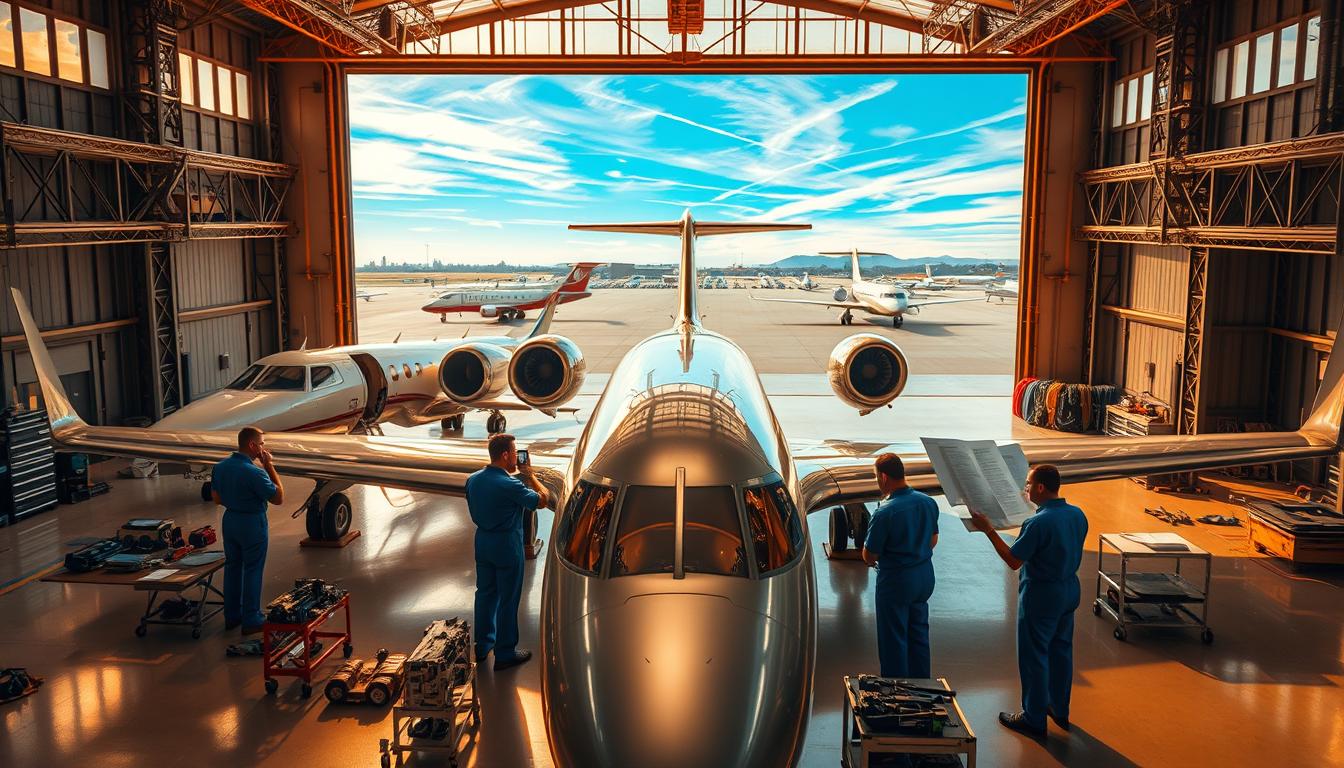When you own or operate a private jet, keeping it in top shape is key. You need thorough MRO services at a private airport to maintain its performance. These services offer everything from routine checks to complex repairs, tailored to your needs.
private jet mro sevices
At a private airport, aircraft maintenance solutions ensure your jet is always ready to fly. Choosing a trusted MRO service means your jet gets expert care. This reduces downtime and makes sure your aircraft is ready for your next trip.
Key Takeaways
- Comprehensive MRO services are available at private airports.
- Regular maintenance is key for top aircraft performance.
- Expert MRO services cut downtime and meet standards.
- Private airport maintenance meets various aircraft needs.
- Aircraft maintenance solutions are made for private jets.
The Critical Role of MRO in Private Aviation
In private aviation, MRO services play a huge role. They affect the safety, efficiency, and performance of private jets. As a private jet owner, keeping your aircraft in top shape is key.
MRO in private aviation
What Constitutes Comprehensive MRO Services
Comprehensive MRO services cover a wide range. They include routine maintenance, repair operations, and overhaul services. These ensure your private jet stays safe and runs well. Key parts of these services are:
- Regular inspections to spot issues early
- Line maintenance to keep your jet flying smoothly
- Base maintenance for deeper repairs and overhauls
- Specialized services like avionics upgrades and cabin refurbishments
Why Specialized Maintenance Matters for Private Jets
Private jets need specialized maintenance because of their unique needs. Specialized maintenance services are made for your aircraft. They ensure repairs or upgrades are done right and fast. This boosts safety and keeps your aircraft’s value high.
Private Jet MRO Services: Core Components and Offerings
To keep your private jet in top shape, it’s key to know what MRO services do. Private jet MRO (Maintenance, Repair, and Overhaul) services make sure your aircraft is safe, runs well, and meets all rules.
private jet MRO services
Line Maintenance Operations
Line maintenance is about routine checks and small fixes done between flights. It’s vital to catch and fix small issues before they grow big. Line maintenance activities include checks before and after flying, finding and fixing problems, and doing minor repairs.
- Pre-flight and post-flight inspections
- Troubleshooting and defect rectification
- Minor repairs and replacements
Base Maintenance Procedures
Base maintenance is a deeper dive into your aircraft’s health. It’s done in a hangar and takes more time. Base maintenance keeps your private jet flying well for a long time.
- Comprehensive inspections and checks
- Repair and replacement of major components
- Overhaul of critical systems
Specialized Service Capabilities
Private jet MRO also offers special services for unique needs. These can include updating avionics, redoing the interior, or boosting performance. With specialized service capabilities, you can make your aircraft just right for you.
Examples include:
- Avionics upgrades and modernization
- Cabin interior refurbishment and customization
- Performance enhancement programs
The Strategic Advantage of Private Airport Facilities
Private airport facilities are changing how private jets are cared for. They offer top-notch security and efficiency. These places are made just for private jet owners, giving a custom experience for maintenance, repair, and overhaul (MRO).
Enhanced Security and Confidentiality
Using private airport facilities means better security and confidentiality. They have limited access, CCTV cameras, and security guards. This keeps your aircraft safe from unwanted visitors or dangers.
Operational Efficiency Benefits
Private airport facilities also boost operational efficiency. They have fast processes and a team focused on your needs. This means your aircraft can get back to flying faster.
Exclusive Amenities for Aircraft Owners
These facilities also offer exclusive amenities for jet owners. You’ll find fancy lounges, personal concierge services, and maintenance plans made just for you.
| Benefits | Description |
| Enhanced Security | Restricted access, CCTV surveillance, and on-site security personnel. |
| Operational Efficiency | Streamlined processes and dedicated staff for quicker maintenance. |
| Exclusive Amenities | Luxurious lounges, personalized concierge services, and tailored maintenance programs. |
Maintenance Programs Tailored for Private Jets
To keep your private jet in top shape, a good maintenance plan is key. It’s all about knowing what your aircraft needs, whether it’s a light, mid-size, or heavy jet.
OEM-Recommended Maintenance Schedules
Original Equipment Manufacturer (OEM) schedules help your jet run smoothly. These plans come from the manufacturer’s deep research and testing.
Light Jets Maintenance Requirements
Light jets need special care because of their size and simplicity. They require regular checks and maintenance, but it’s less than bigger jets.
Mid-Size and Heavy Jets Considerations
Mid-size and heavy jets need more detailed care. They have more complex systems and require more frequent checks.
| Jet Category | Typical Maintenance Interval | Key Maintenance Tasks |
| Light Jets | Every 100-200 flight hours | Routine inspections, engine checks, and minor repairs |
| Mid-Size Jets | Every 150-300 flight hours | Comprehensive system checks, cabin interior inspections, and engine performance monitoring |
| Heavy Jets | Every 200-400 flight hours | Detailed inspections of all critical systems, structural checks, and advanced diagnostic testing |
Customized Maintenance Solutions
Custom plans can fit your jet’s unique needs. These plans adjust to how often you fly, where you fly, and your jet’s specific setup.
Avionics Maintenance and Technological Upgrades
As a private jet owner, you know how vital avionics maintenance is. It keeps your aircraft safe and efficient. Avionics maintenance covers many services to update your aircraft’s systems.
Keeping these systems in top shape is key for your aircraft’s performance and safety. Regular checks and updates are needed to meet the latest aviation standards.
Flight Management System Maintenance
The Flight Management System (FMS) is essential for your aircraft’s navigation and flight planning. It needs regular maintenance. This includes software updates and system checks to ensure it works well.
Communication and Navigation Equipment Services
Good communication and navigation are critical for safe flying. Maintenance services check and fix these systems. They replace radios and antennas to meet safety standards.
Cockpit Modernization Options
Upgrading your aircraft’s cockpit can boost its value and performance. You can get modern glass cockpits or advanced autopilot systems. These upgrades improve safety and pilot efficiency.
| Avionics System | Maintenance Activities | Benefits |
| Flight Management System | Software updates, database refreshes, system checks | Improved navigation accuracy, enhanced performance monitoring |
| Communication Equipment | Inspection, repair, replacement of radios and antennas | Reliable communication, compliance with regulatory requirements |
| Navigation Equipment | Inspection, repair, replacement of navigation aids | Enhanced situational awareness, improved safety |
Cabin Interior Refurbishment and Upgrades
As a private jet owner, you know how vital a great cabin interior is. It’s not just a space; it’s a reflection of your style and a key to your passengers’ comfort. Keeping your cabin in top shape is essential.
Soft Goods Restoration and Replacement
Seats, carpets, and curtains wear out over time. It’s important to restore or replace them to keep your cabin looking and feeling luxurious. High-quality materials and craftsmanship are key for a premium feel. You can choose from reupholstering seats to swapping out old carpets for new ones that fit your design.
Cabinetry and Hard Surface Maintenance
Cabinetry and hard surfaces need regular care to avoid damage. This includes polishing, fixing or replacing damaged parts, and making sure all hardware works right. Attention to detail is vital to keep your aircraft’s interior at its best.
Entertainment and Connectivity System Services
Modern private jets have advanced entertainment and connectivity systems. Keeping these systems updated is critical to ensure they work well and meet your passengers’ needs. Services might include updating software, swapping out old parts, and adding new tech to improve the flight experience.
| Service | Description | Benefits |
| Soft Goods Restoration | Reupholstering, carpet replacement | Enhanced comfort, luxurious appearance |
| Cabinetry Maintenance | Polishing, repair, replacement | Prevents damage, maintains aesthetic |
| Entertainment System Upgrades | Software updates, hardware replacement | Improved functionality, enhanced passenger experience |
Engine Maintenance and Performance Optimization
To keep your private jet running smoothly, regular engine maintenance is key. It boosts performance and extends your aircraft’s engine life.
Routine Engine Inspection Protocols
Regular checks are essential to catch problems early. They look for wear, oil leaks, and other signs of damage.
Performance Monitoring Systems
Advanced systems track engine health in real-time. This lets you fix issues quickly and keep performance high.
Complete Engine Overhaul Services
A full engine overhaul is a detailed process. It involves taking apart, inspecting, and fixing or replacing parts. This keeps your engine running well and reliably.
Time-Based Overhaul Requirements
Engines need overhauls after a set number of hours. This ensures they’re checked regularly, no matter their condition.
On-Condition Maintenance Approaches
On-condition maintenance is based on the engine’s actual state, not a schedule. It’s often more efficient and saves money.
| Maintenance Type | Description | Benefits |
| Routine Inspection | Regular checks for wear and tear | Early detection of issues |
| Performance Monitoring | Real-time tracking of engine health | Prompt issue resolution |
| Engine Overhaul | Comprehensive refurbishment of engine components | Restored engine performance and reliability |
By using these engine maintenance strategies, your private jet will stay in excellent shape. It will operate safely and efficiently.
Airframe Inspection and Structural Integrity
The airframe is the core of your private jet. Its inspection is key for safety and performance. Keeping the airframe strong is vital.
Corrosion Prevention and Treatment Programs
Corrosion can weaken your aircraft’s airframe. It’s important to prevent and treat corrosion. Regular checks, cleaning, and protective coatings are part of these programs.
Good corrosion prevention saves money and keeps your jet flying. Choose a maintenance team with experience in these programs.
Structural Assessment Methodologies
Methods for checking your aircraft’s airframe are used to see its condition. These include visual checks, non-destructive tests, and looking at maintenance records.
| Methodology | Description | Benefits |
| Visual Inspection | Trained technicians look for damage or wear on the airframe. | Finds problems early |
| Non-Destructive Testing | Ultrasonic testing and radiography check hidden areas. | Finds hidden damage |
| Maintenance History Analysis | Looks at maintenance records for clues about future needs. | Forecasts maintenance needs |
Advanced Non-Destructive Testing Techniques
Advanced NDT methods are key for your aircraft’s airframe. Ultrasonic testing and radiography check hard spots without harm.
Using these NDT methods keeps your aircraft safe and avoids surprise repairs.
Regulatory Compliance and Certification Standards
Keeping up with regulatory compliance is key in private jet maintenance. It affects both safety and how well the jet operates. As a jet owner, you need to make sure your maintenance team follows strict rules.
Following these rules is complex. It involves many standards and steps. The Federal Aviation Administration (FAA) is a big part of this in the U.S.
FAA Requirements for Business Aviation
The FAA has clear rules for business jets. These include how to maintain and inspect them. Your maintenance team must know these rules well.
They need to follow FAA-approved maintenance manuals and airworthiness directives. This keeps your jet safe and legal.
International Maintenance Standards Adherence
International standards are also important. Groups like the International Civil Aviation Organization (ICAO) and the European Aviation Safety Agency (EASA) set global rules. These rules affect private jet maintenance worldwide.
Documentation and Recordkeeping Protocols
Keeping accurate records is vital. Your maintenance team must document all work done on your jet. This helps follow rules and track your jet’s maintenance history.
Aviation experts say following rules is not just to avoid fines. It’s about keeping your jet safe and reliable. Choosing a maintenance team that follows rules is essential for your jet’s safety and value.
AOG Support and Emergency Maintenance Solutions
When your private jet is grounded, quick AOG support and emergency maintenance are key. Aircraft on Ground (AOG) issues can cause big delays and mess up your travel plans. Good AOG support means your plane is fixed fast, cutting down on downtime.
24/7 Technical Response Teams
A 24/7 technical response team is essential for quick fixes. They offer fast help, figuring out problems and fixing them quickly. Their skills get your plane flying again fast, lessening the effect of sudden maintenance needs.
Mobile Repair Capabilities
Mobile repair capabilities let teams fix your plane where it is. This is super helpful in AOG situations, saving time and getting your plane airborne sooner.
Parts Logistics and Supply Chain Management
Good parts logistics and supply chain management are vital for AOG support. Keeping a big stock of parts and a solid supply chain means quick access to what’s needed. This cuts down on delays and gets your plane flying again quickly.
Financial Considerations for Private Jet Maintenance
Managing your private jet’s finances is critical for keeping it in top shape. As a jet owner, knowing the financial side of maintenance is essential.
Budgeting Strategies for Routine Maintenance
Creating a solid budget for routine maintenance is key. You need to know your aircraft’s maintenance needs and plan your budget. Consider your aircraft’s age, how often you fly it, and any special needs it might have.
Managing Unscheduled Maintenance Costs
Unexpected maintenance can hit your wallet hard. To avoid this, keep a reserve for unexpected costs. Also, consider a maintenance program for regular checks to catch problems early.
Maintenance Program Subscription Options
Subscriptions for maintenance can save you money. There are several options, including:
- Hourly maintenance programs that charge based on flight hours
- Fixed-cost maintenance plans that offer predictable expenses
Hourly Maintenance Programs
Hourly programs are great if your flying schedule changes. You only pay for maintenance when you fly.
Fixed-Cost Maintenance Plans
Fixed-cost plans, on the other hand, offer a set fee each year or month. This makes budgeting easier, as you know what to expect.
| Program Type | Description | Benefits |
| Hourly Maintenance | Charges based on flight hours | Pay only for what’s used |
| Fixed-Cost Maintenance | Predictable annual/monthly fee | Eases budgeting and financial planning |
By understanding your options and picking the right program, you can handle the financial side of jet maintenance well.
Selecting the Ideal MRO Partner for Your Aircraft
Private jet owners need to pick their MRO partner wisely. This choice impacts your aircraft’s safety, efficiency, and value. The right MRO ensures your jet gets top-notch maintenance, meeting strict aviation standards.
Evaluating Technical Expertise and Capabilities
When looking at MRO partners, check their technical expertise and capabilities. Look at their certifications, experience with your aircraft, and services offered. A good MRO has a solid track record and can handle all maintenance needs.
Assessing Service Quality and Reputation
The service quality and reputation of an MRO matter a lot. Research their customer feedback, ask for references, and see how they’re viewed in the aviation world. A trusted MRO offers excellent service and builds strong client relationships.
Location and Accessibility Considerations
The location and accessibility of an MRO are key. A nearby MRO cuts down on downtime and speeds up maintenance. Also, think about the local amenities and support services, which can improve the maintenance experience.
By carefully looking at these points, you can find an MRO partner that meets your aircraft’s needs. This partner will help your jet perform better and last longer.
Cutting-Edge Technologies in Modern MRO Operations
New technologies are changing how private jets are kept in top shape. These advancements make MRO operations more efficient, safe, and reliable.
Predictive Maintenance Innovations
Predictive maintenance is key in today’s MRO services. It uses smart data and algorithms to spot problems before they happen. This cuts downtime and boosts aircraft availability.
Digital Documentation and Tracking Systems
Digital systems are making MRO work smoother. They give updates and detailed records of maintenance. This makes things clearer and helps meet rules.
Remote Diagnostics and Monitoring Solutions
Remote tools let MRO teams check aircraft anytime. This helps fix unscheduled maintenance fast.
Using these new technologies, MRO services get better. They become more efficient, reliable, and affordable for private jet owners. As the field grows, using these innovations will keep MRO ahead.
Environmental Sustainability in Private Jet Maintenance
The private jet maintenance sector is moving towards more eco-friendly practices. This change is driven by the need to lessen its environmental impact. As a private jet owner or operator, you’re expected to adopt maintenance that’s good for the planet and keeps your aircraft safe.
Eco-friendly maintenance is key in this shift. It includes using green cleaning products, cutting down on water and energy use, and recycling materials like metals and fluids.
Eco-Friendly Maintenance Procedures
Starting eco-friendly maintenance involves several steps. Choose cleaning products that are safe for the environment and don’t harm it. Maintenance facilities are also using energy-saving tools and renewable energy to power their work.
Sustainable Materials and Waste Reduction
Using sustainable materials in maintenance is vital. This means picking materials that can be recycled or reused. It’s also important to have effective waste reduction plans. Many MRO providers are now recycling a lot more.
| Eco-Friendly Practice | Environmental Benefit | Implementation Strategy |
| Biodegradable cleaning products | Reduced chemical pollution | Replace traditional cleaning products with eco-friendly alternatives |
| Energy-efficient equipment | Lower energy consumption | Invest in LED lighting and energy-efficient machinery |
| Waste recycling programs | Reduced landfill waste | Implement recycling for metals, fluids, and other materials |
By using these eco-friendly methods, you help make the aviation industry more sustainable. You might also save money on maintenance over time. Keeping up with the latest in sustainable maintenance is important for reducing your environmental impact.
The Future of Private Jet MRO Services at Private Airports
Private airports are key to the future of MRO services. They will use new technologies and service models. As private flying grows, so does the need for top-notch maintenance.
Emerging Technological Trends
New tech is changing MRO services. Predictive maintenance uses AI to plan ahead and cut downtime. Digital systems also make maintenance more open and efficient.
Evolving Service Models and Customer Expectations
Customers want more from MRO services. They want services that fit their needs. Customized maintenance programs and subscription-based models are now popular. They offer flexibility and predictable costs.
Infrastructure Development Forecasts
Private airports need better infrastructure for MRO services. New hangars, tools, and facilities will boost capacity. Here’s what’s planned at key airports:
| Airport | Projected Development | Completion Date |
| Airport A | New Hangar Facility | 2025 |
| Airport B | Advanced Tooling Upgrade | 2024 |
| Airport C | Expansion of Maintenance Facilities | 2026 |
These upgrades will make MRO services better and improve the flying experience. They set a new standard for the industry.
Conclusion: Maximizing Your Aircraft Investment Through Quality Maintenance
As a private jet owner, your aircraft is a big investment. It needs careful maintenance to last long and perform well. Quality maintenance is key to getting the most out of your aircraft, ensuring a safe and efficient flight.
This article has shown how MRO services are vital in private aviation. They offer complete maintenance programs, specialized services, and follow all rules. Choosing the right MRO partner and investing in quality maintenance protects your aircraft. It also gives you a better flying experience.
To get the most value from your aircraft, you need to be proactive about maintenance. This includes regular checks, monitoring performance, and fixing issues quickly. Quality maintenance helps avoid downtime, cuts costs, and keeps your aircraft safe and up to code.
By focusing on quality maintenance, you can keep your aircraft in top shape. This way, you can enjoy the perks of owning a private jet for many years.
FAQ
What are the benefits of using a private airport for MRO services?
Private airports for MRO services offer many advantages. They ensure better security and privacy. They also improve operational efficiency and provide exclusive amenities for aircraft owners.
What constitutes a complete MRO service for private jets?
A complete MRO service for private jets includes several key areas. It covers line maintenance, base maintenance, and specialized services. These ensure the aircraft is always in top shape and safe to fly.
How do I choose the right MRO partner for my private jet?
To find the right MRO partner, look at their technical skills and service quality. Also, consider their location and how easy it is to get to them.
What are the different types of maintenance programs available for private jets?
There are many maintenance programs for private jets. These include following OEM schedules, custom plans, and subscription services. Options like hourly or fixed-cost plans are available.
How can I minimize the environmental impact of MRO activities?
To reduce the environmental impact of MRO, use eco-friendly methods. Choose sustainable materials and focus on waste reduction.
What are the latest technological trends in MRO operations?
New tech trends in MRO include predictive maintenance and digital systems. Remote diagnostics and monitoring are also becoming more common.
How do regulatory requirements impact private jet MRO services?
Regulatory rules, like FAA standards, affect private jet MRO. Strict adherence to these rules is essential.
What is the importance of airframe inspection and structural integrity?
Airframe inspection and structural integrity are vital. They keep private jets safe to fly. This includes preventing corrosion and using advanced testing methods.
How can I manage unscheduled maintenance costs for my private jet?
To control unscheduled maintenance costs, plan ahead. Use budgeting and consider maintenance subscriptions. These can help avoid unexpected expenses.
What are the benefits of AOG support and emergency maintenance solutions?
AOG support and emergency maintenance offer many benefits. They include 24/7 teams, mobile repairs, and efficient parts management. These ensure quick and effective emergency fixes.







